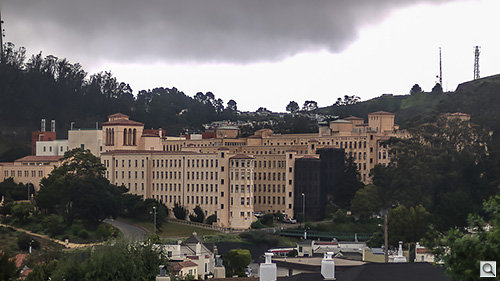Photo Corners headlinesarchivemikepasini.com
![]()
A S C R A P B O O K O F S O L U T I O N S F O R T H E P H O T O G R A P H E R
![]()
Enhancing the enjoyment of taking pictures with news that matters, features that entertain and images that delight. Published frequently.
Friday Slide Show: A Walk In The Rain




25 March 2016
It was Sunday. It was raining. We were expecting visitors in a while. We had nothing to do. We took a camera on a walk and shot the neighborhood between what metiorologists like to call "isolated showers." And photographers refer to as "targeted attacks."
As we sat down to write about this week's slide show, though, we realized that was just a small part of the story.
We wanted to take a walk because we insists on some kind of exercise every day just to keep the blood flowing north to our brain. Even though it was raining off and on, we felt a short trip around the neighborhood would do more good than bad.
But we brought the Olympus Micro Four Third camera with us because 1) it was small enough to protect under our rain jacket and 2) we had put an old 50mm f1.4 Nikkor on it with the help of a Lensbaby Tilt Transformer.
There were two things we liked about Item 2.
OK, that was the hardware aspect of this shoot. And a lot of stories might end there. But not with us.
The first is the focal length. The kit lens runs from 14-42mm so 50mm got us closer than usual. The second was that the EVF we had on the Olympus would accurately inform both our focus and exposure.
Even with the help of the EVF, though, we found it difficult to judge depth of field. We probably should have switched to the LCD for a larger image.
OK, that was the hardware aspect of this shoot. And a lot of stories might end there. But not with us.
We pulled these images into Lightroom CC, synced our edits to each of them and, well, didn't much like what we saw. So we tried the set of 11 images as black-and-white images. Nope.
Hmmm.
It took a heart beat or seven to remember we had wanted to process these images through Piccure before importing them into Lightroom. It wasn't just the old lens, but the gloomy light and compromised coupling of the optics to the camera.
That made a big difference. The images were sharper than we'd been able to get them in Lightroom alone. And the colors and tone were more accurate. Just to ice the cake, our Clarify preset enhanced the images even more -- and much more impressively than it had on the original Raw images.
Piccure, though, was looking at the Raw image and ignoring (as Lightroom does not) the aspect ratio crop we had imposed in the camera. We were amused to be overridden. But we appreciated the pseudo criticism. So we let it stand.
A small camera with an old optic pre-processed with an unusually effective utility before being edited in Lightroom. That's a journey that balances gear with software to get to a place neither by themselves could reach.
Now ask yourself where else you've heard that story?
